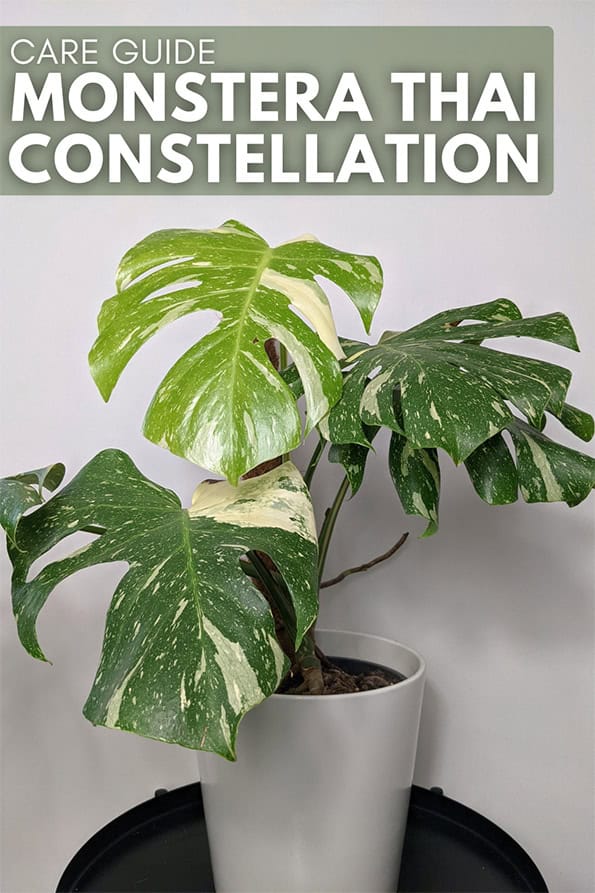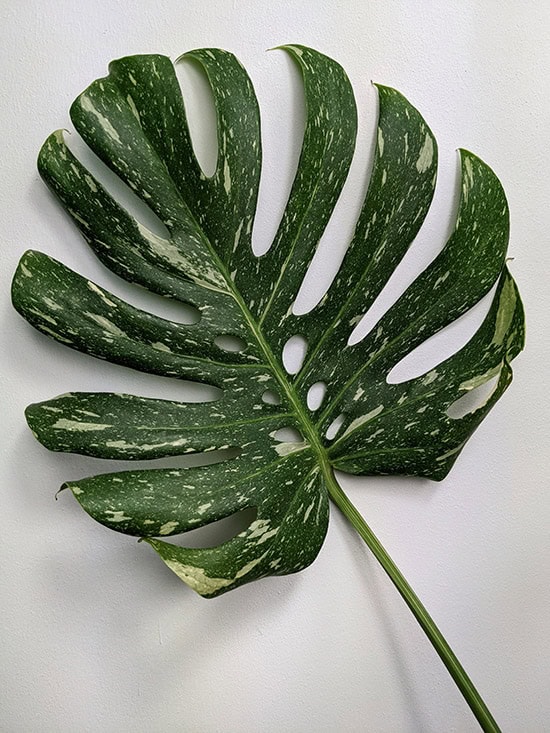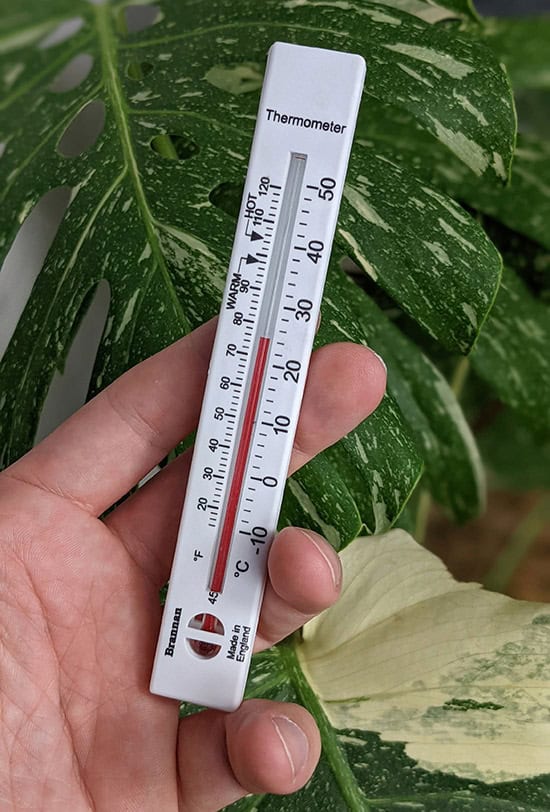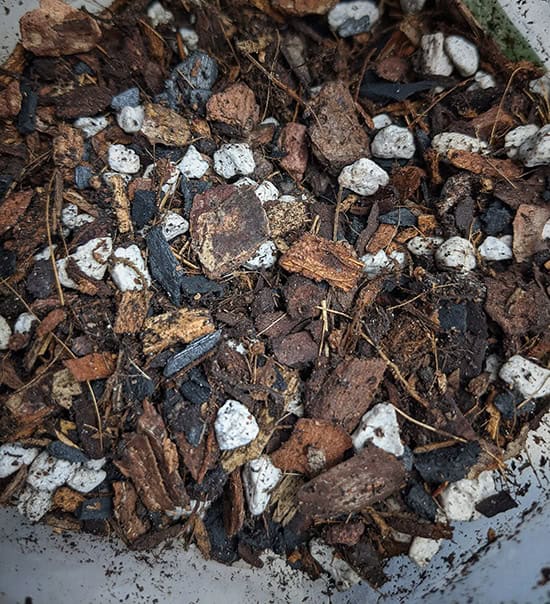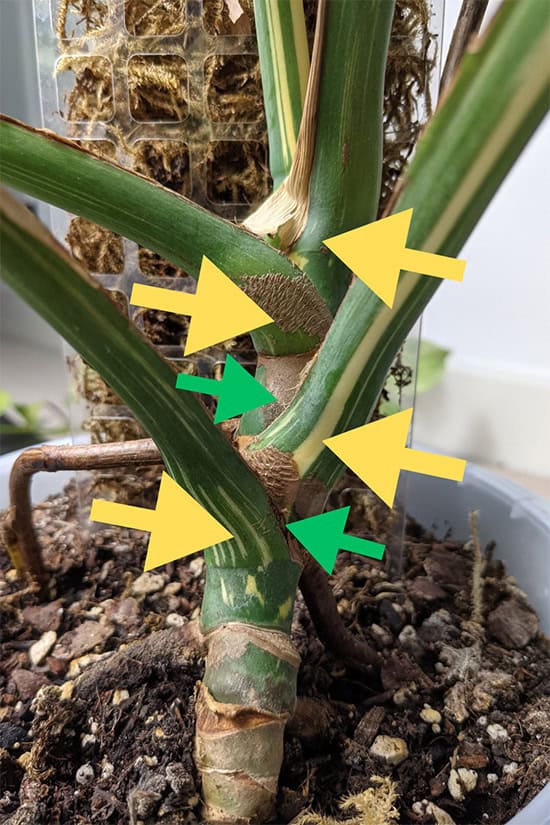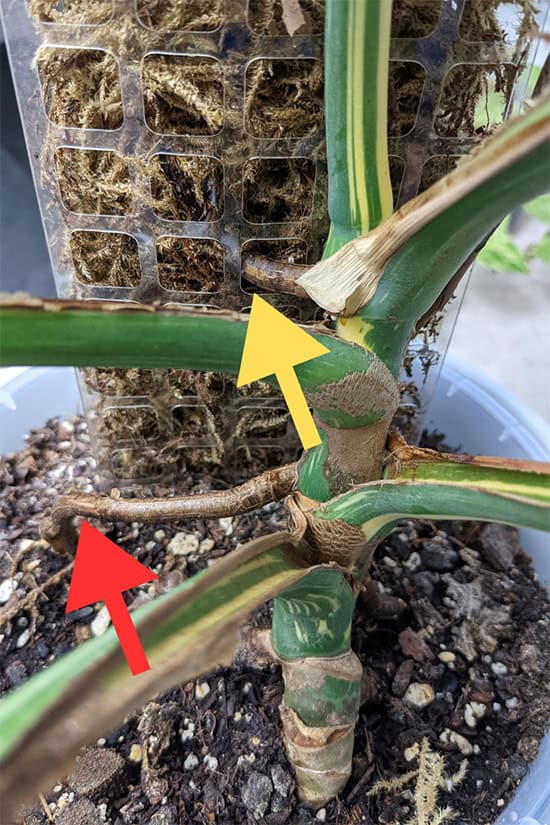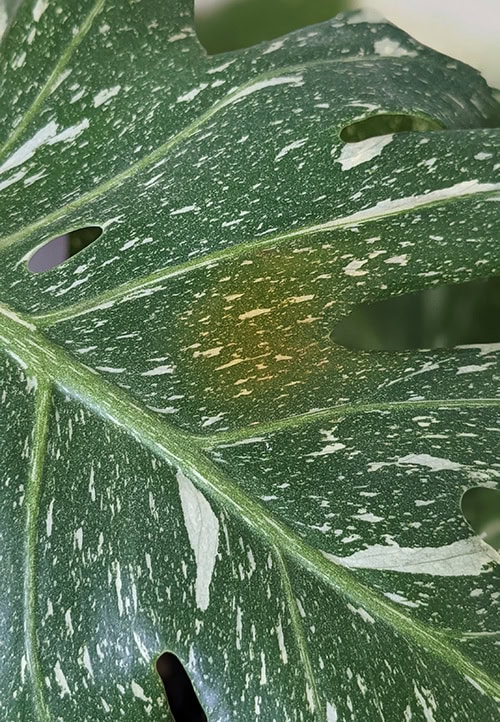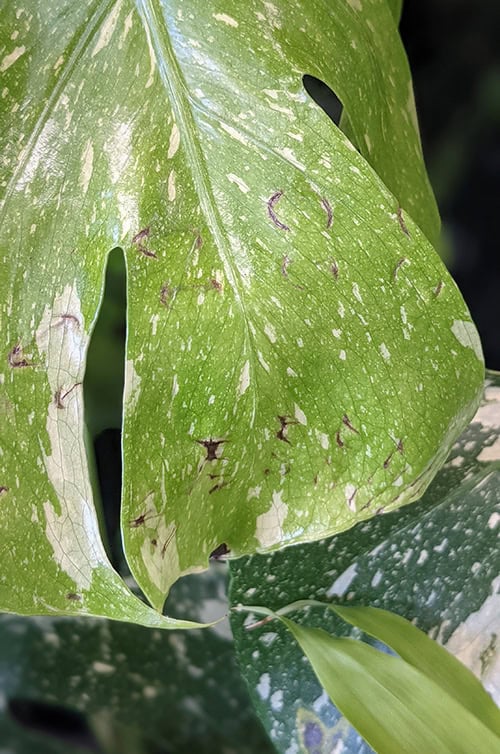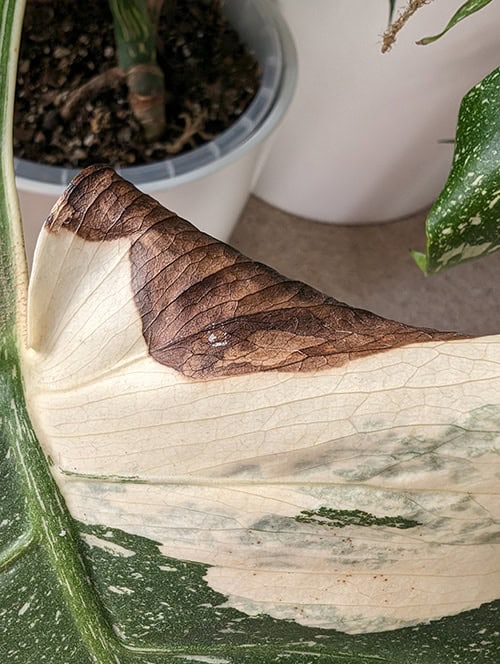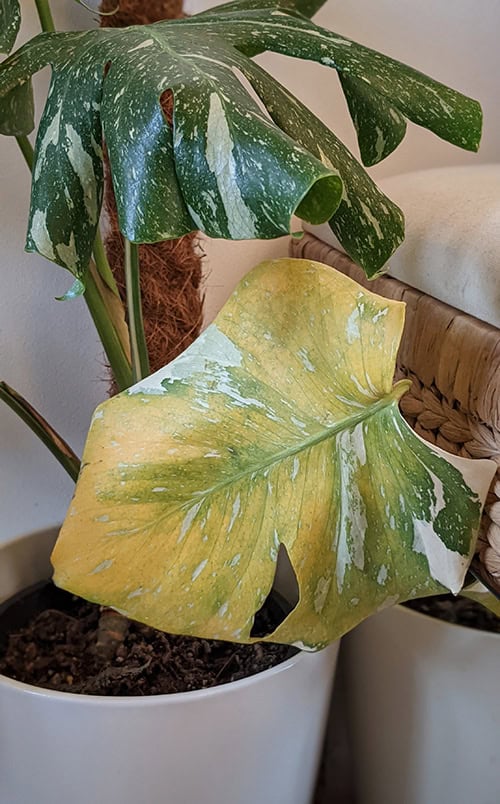A stunning variety of the popular Monstera deliciosa plant, the Monstera Thai Constellation is known for its distinctive, speckled variegated leaves. The leaves have unique creamy white splashes that draw the eye and will make a statement plant in any collection.
It's a relatively expensive houseplant (although prices are coming down) and its unfounded reputation of being fussy and hard to care for that may put people off getting one.
In my experience, it's only a touch more difficult than the traditional all green Monstera, so if you can afford one, don't let that supposed difficulty factor put you off.
The Monstera Thai Constellation is a special and expensive plant. So once you've got one, it's too easy to treat it like a Queen and over fuss it. They do a lot better if you give them less attention and just let them get on with it.
The variegation on the plant is caused by a genetic mutation and because it's part of the plants DNA, it's considered to be "stable". This means every leaf the plant produces should have a similar degree of variegation.
It's normal for some leaves to have more or less markings than the other leaves, but what you can expect from leaf to leaf is generally fairly predictable.
The Thai Constellation is often confused with the Monstera Albo, another stunning variegated Monstera. However once you know the differences between the two, they're very easy to tell apart.
How do you pronounce Monstera Thai Constellation? Say:
MON-steh-ruh THAI Kon-stuh-LAY-shun
The plant's common name 'Thai Constellation' comes from the fact the plant was discovered in Thailand. There is some general misinformation suggesting that these plants were actually created in a lab in Thailand in the last decade and this is the reason for the common name.
However there is now reasonably solid evidence that suggests this plant was actually found in the 1980s growing in the wild in Bangkok and started to be sold in 2003. (Chris from Pretty In Green covers this in a YouTube video if you want to learn more).
The 'constellation' part of the name is more straightforward. It was named because the leaves resemble a night sky filled with stars.
The Thai Constellation Monstera is a magnificent plant, with its beautiful starry night sky like markings and fenestrated leaves.
These plants are quite difficult to propagate (more on this later), so their price has been high for many years. In recent years, a lab in Thailand found a way to tissue culture these plants enabling them to be mass produced.
For a long time this lab was the world's main supplier of the Thai Con, making them super rare. And as I explain in my "Why are some houseplants so expensive" article, rare plants will command a premium for as long as they stay rare.
Times change and the plant has become more widespread so the prices are tumbling. I'll assume you're lucky enough to have one of these plants (or thinking of getting one) so I'll get on with the care guide and share some tips and tricks of what I've learned from owning mine over the last few years.

Hi, I'm Tom!
If you're like me and enjoy the challenge of growing houseplants and getting them to thrive, then Ourhouseplants can help. This website shares my knowledge and years of growing plants and provides (hopefully) helpful advice on properly caring for your indoor plant friends.
Most Monstera plants do okay growing in a medium light location and the Thai Constellation is largely the same. It's directly related to the more widespread Swiss Cheese Plant, and that one can quickly put out impressive growth over a growing season.
However, the beautiful creamy white variegation on the Thai Con lacks chlorophyll, which means those areas of the leaf are unable to photosynthesis, slowing down the plant's energy generation.
Lower amounts of energy means a slow growing plant. To combat this I would suggest putting your plant in a brighter location, or supplementing with a grow light. They can even cope with a little sunshine, but they do burn easily if the sun is too strong (as I've found out) so you need to be careful.
Top Tip - Holes or no?
A container with drainage holes is practically essential. Sometimes, as plant parents, we can judge and guess watering needs when using a planter without any holes, and things go okay. But this is an expensive plant, don't take the risk of accidentally overdoing it one day.
The biggest issue with these plants is overwatering. They are tough plants, but too much water, too frequently can finish them off quite fast. It's really important to let the potting mix dry out almost entirely between waterings.
A lot of people will recommend soaking the soil until water pours out of the drainage holes in the pot (if it has any!). However you don't necessarily need to drench the mix like this.
I rarely do soil drenches for any of my houseplants as it does push up the risk for root rot. I water my plants well and then back off before the mix gets too wet.
I imagine that most people who own a Thai Con are going to have had experience with houseplants. Of the two options above, pick which works for you generally and your other plants.
Top Tip - Moisture Meter
A Moisture Meter can be an invaluable tool. Mine has helped me out many times over the years. You can use it for all your houseplants too, so they can be worth the investment (and are quite cheap too). I talk about the one I use here, if you're interested.
When the temperature drops and the light levels go down at the end of the growing season you will need to water a lot less often. Even though my plants are in my warm living spaces, I may only water them every three weeks during Winter. It's really essential to avoid having them sitting around in soggy soil.
Try and grow them in moderate to high humidity environments, anything above 50% should be ideal.
Crispy leaf edges or browning are all possible signs that the plant needs higher humidity. If you spot these problems, or you know you have below 50% humidity levels in your home, then you may need to think about finding ways to boost it.
Generally these plants won't grow all year around so you'll only need to feed them every 4-6 weeks during the growing season (Spring and Summer).
Reduce feeding frequency or cease altogether during the dormant period in Fall and Winter. If your plant continues to push out new growth, then by all means continue to feed.
An all purpose houseplant feed will work, but you can always pick a specialist one designed for foliage plants.
Try and grow your plant somewhere between 65°F to 85°F (18°C to 29°C) for best results. They're typically quite tolerant plants of cooler rooms (within reason), although they won't be happy in cold conditions for prolonged periods.
They're tropical plants and in their native habitats anything below 68°F (20°C) is uncommon, so keep them warm all year round.
Should you use a Clear Container?
If you've spent any time looking at these plants on Instagram or YouTube you'll notice that plant influencers on these platforms often use see through pots (myself included). While they're not essential, they let you see the root health of the plant and assess how dry (or wet) the potting mix is at a glance. For those reasons I think they're a good idea. But they can be grown perfectly well in standard nursery pots.
Young plants just brought from the store are likely to need repotting shortly after getting home. They're going to need more root space in order to produce new leaves.
Semi mature plants will need less repotting, potentially once every few years.
Mature plants and those growing on proper moss poles will need even less repotting. Ideally around every 3 years.
Choose a container that's a little larger than the current one. This reduces the chances of overwatering issues but also gives plenty of space for the roots to grow into.
Place a layer of well-draining potting mix (more on this next) at the bottom of the new pot, then position the plant in the center, or to your liking. Fill in around the roots with additional potting mix, pressing it down lightly to secure the plant. Water the plant well to help everything settle into place.
Most Monstera Thai Constellation plants will be sold in a peat based potting mix. It's generic and often used for all the plants that the seller or shop sells. Your plant will grow in this potting soil, but it's arguably not ideal as it holds so much water and again risks you falling into overwatering problems.
Most sellers will tell you to pick an aroid Mix. You can see what this typically looks like in the photo below. Lots of chunky material like orchid bark combined with inorganic elements like perlite and horticultural charcoal.
Mixes like this are very chunky they can be a great way to avoid excess water being held around the plant's roots. My Monstera Thai Constellation plant didn't get on with this mix and if yours doesn't either, you can go for something a little more dense.
I tried an aroid mix but my plant didn't take to it. It could just have been my experience, but after a year of no growth, I started again. I reused a good amount of the same aroid mix but mixed it up with 1 part worm castings to 5 parts coconut coir to add more organic matter.
Although this did increase the potting medium's watering holding capacity, I've been very careful not to overdo it with the water. My plant has started growing again so I'm sticking with this going forward.
Earlier I mentioned that the Monstera Thai Constellation is tricky to propagate and now I'll explain why.
In principle you propagate these plants the same way you would any Monstera, and that's typically through stem cuttings. To do this you cut just below a leaf and a node (they're usually opposite one another on the stem) and then it goes into some water or a potting mix.
After a month or so it will hopefully start growing new roots. If propagating by water, once the roots have reached a decent size you can then move them into a potting mix to grow on.
The reason it's difficult can be illustrated in the photo below.
The Thai Con is tricky to propagate successfully through stem cuttings. Although even with a basic level of plant knowledge it can be done.
The larger yellow arrows represent the start of the leaf petiole leading up to the actual leaf. The Smaller green arrows are the very short internodal spaces where you would need to cut to create the stem cuttings.
Most Monstera plants would have much larger internodal spaces, at least a few inches. On the Thai Constellation its way shorter and so you likely won't have enough stem to bury it or submerge it in water without some of the plant's leaf coming into contact with the soil / water too. Increasing the chances of it rotting.
The solution is to cut at the lower green arrow, then remove the leaf directly above it. To give yo a little more space. But that means removing a valuable leaf and a fair amount of the plant for a cutting that might not actually "take".
For a less risky approach you can try air layering. Darryl over at Houseplant Journal has a detailed Instagram reel that explains the process.
Not a Fan of Reels?
If you'd rather see photos of the process, I've done it on my Monstera Albo, and you can read about it here. Although the plants are a little different, the principle is the same.
If you want to propagate your Thai Con, but don't want to risk losing a large section of your plant, give the air layering option a go.
Even if you provide the right conditions, the Thai Con has an average growing speed. It's generally slower than the typical all green Monstera and on occasion it's slower than even the Albo (depending on how variegated the Albo plant is).
Focus on providing good light levels and if you notice growth is still only crawling along, it could be time to think about repotting or providing a moss pole. It will take a while for the plant to grow into the new container and for the aerial roots to establish themselves into the growing support. But once it's settled and happy it should start to grow faster.
It's a Monstera. It's going to get very big eventually and in time it will fill any indoor garden! However the Thai Constellation has a more compact and "spread" growth habit. Yes, it will grow upwards, but it also goes wide and spreads out, even when it's still pretty short, more so than other Monstera which all generally prefer to climb.
The Thai Constellation has potential to flower. In most homes this is unlikely, but if after many years it's developed into a large and established plant it may flower and produce edible fruit. Bare in mind the fruit takes an extremely long time to ripen and you only have a specific window to eat it. Here is a YouTube Video of The Kiwi Grower explaining it better than I can.
The leaves and stems contain insoluble calcium oxalate crystals, which can cause irritation and discomfort if ingested. It's not been flagged as a toxic plant because there have been so few reported cases of problems. However, most parents and pet owners will want to avoid an upset stomach, so watch your plant and pets to make sure they play nicely together.
The Monstera Thai Constellation produces aerial roots. Typically, you'll get at least one root for every leaf produced. Some people don't like them and remove them.
You can do this, but in my experience, the Thai Con is a somewhat anxious houseplant. Although it does well on neglect, it likes to feel physically secure before it pushes out decent growth. The aerial roots will help with this.
These roots want to either root into the potting mix, or grow into a moss pole (or other porous support). You can see this happening in the photo below.
Aerial roots do have a purpose for Aroid plants and I don't recommend routinely removing them in most cases.
The aerial root at the yellow arrow has grown into the sphagnum moss support. The red arrow is pointing to the root that's growing into the potting mix. I can't show you in a photo but this plant is now locked into place. Everything is firm. I can lift and hold the entire plant from the central stem alone.
This is ideally what you want to happen. A secure plant is one that will grow happily and give you lots of brand new leaves.If it's flopping around, you'll likely have a poor growing plant which may also lack fenestrations. So yes, you can trim off the aerial roots, but it's not something I'll be doing on my plants.
Yellow marks on the leaves.
This will be caused by pests like Spider Mites or Thrips or from sun damage. In the photo that follows you can clearly see a yellow circle on a leaf. It was caused by intense late morning sun falling onto the plant during my last Summer.
The light was too intense and this is what happened. Shield your plant from the harsh rays or position them in a window with less sunshine.
Leaf burn showing clearly on this leaf.
Brown marks and circles on the leaf.
This is damage caused to the leaf before it unfurled. The new leaves are very delicate, and rough handling can bruise them, which becomes very visible when they've fully opened. It's best to protect the leaves and avoid touching them.
This looks bad, but is actually only cosmetic damage. Take care when handling or passing by new leaves.
Thrips.
Unfortunately, Thrips love Monstera plants. Although the Thai Con is very expensive and special for many people, Thrips don't care and will be quite happy to damage your plant like any other.
Variegation going brown.
The browning of variegated leaves on a Monstera Thai Constellation can be caused by several factors.
The lack of chlorophyll on parts of the leaves make these areas extra likely to go brown if conditions aren't quite right.
Poor Fenestrations / Splits in the leaves.
You need a happy plant for large fenestrations to form. Treat them well.
You also need a moss pole or support for the aerial roots to grow into. Once your plant feels secure and is able to grow upwards, new larger leaves will form that start producing the familiar splits in the leaves.
Yellow Leaves.
If the leaves on your Monstera Thai Constellation are turning yellow, it could be a sign of several common issues.
Even for experienced plant enthusiasts or seasoned plant parents, seeing yellow instead of dark green leaves is always disappointing.
The most common reason for yellowing is natural aging. The leaves won't last forever and they do go yellow in time. If it's just one leaf every 6 months it's fine.
Another common reason is overwatering, which can cause the roots to become waterlogged and lead to yellowing leaves. To stop this happening let the soil dry out at least a little between waterings and ensure your pot has proper drainage.
Other things to consider (but they're less likely) is underwatering and too little light. If you plant is looking a little ill in general and has done for a few months, it's potentially down to these reasons.
The final reason is a pest like Thrips, which will do cumulative and continuous damage to a leaf until the plant eventually chooses to discard it.
Not Growing.
If your Monstera Thai Con isn't growing then check out this section above for further tips and suggestions.
